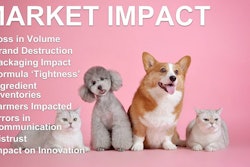
We find ourselves in a marketplace where a large category of pet food ingredients has been associated with the incidence of dilated cardiomyopathy (DCM) in dogs. Theories have been dogmatically presented to consumers as fact, and the presentation of information is frequently incomplete. How did we get here? And, what is a reasonable counterpoint to this demonization of ingredients?
The facts point to genetic predisposition of disease and breeding selection along with how pets are being fed. These factors have a higher impact on overall health than the ingredient source used in a particular dog food.
Do most pets eat only a complete and balanced pet food?
Basic nutrition teaches that nutritional balance and fortification are critical in bone growth, muscle development and other metabolic functions. Too much of one nutrient can have a dramatic impact on others. Pet food nutrient profiles for claims of completeness, balance and 100% nutritious embody years of nutrition science to ensure the right concentrations and ratios of nutrients for the long-term health of our pets. If a pet were to eat only a complete and balanced food, we could have confidence of a reasonably healthy life for that pet. Typically, only commercial pet foods follow nutritional principles that are called complete and balanced – other edible products do not.
According to Mintel, 75% of U.S. consumers confirm that they show love to their pets through treating, and 24% give treats for health-related issues. Results from multiple focus groups indicate consumers rarely feed only one complete and balanced pet food. By our estimates in dealing with hundreds of consumers, it is likely that more than 90% of all pet owners are feeding other edibles (biscuits, chews, dental products, supplements, food scraps, toppers, broths, rawhides, etc.) with their pet foods and do not consider these part of a daily food regimen. If the total food regimen were required to meet guidelines set forth by the Association of American Feed Control Officials (AAFCO) as complete and balanced, most would fail.
What else pets are eating and the nutritional impact
When asked, “What do you feed your pet?” the typical consumer answers, “This or that food.” If asked, “What treats do you feed?” the answer is, “Just a few or none.” However, when asked, “When do you feed biscuits, or soft-moist bacon or rawhide?” the truth comes out. Bottom line: Dietary histories from consumers are not well documented.
In our studies, only a few consumers feed a single, well-balanced food while following the published feeding guidelines using some sort of measuring device. Additionally, consumers might add five dental bones/week, two moderate biscuits/day, one to two moderate soft-moist treats/day, five rawhide chips/week and several table scraps of various sizes and flavors. The balance of this food regimen adds 40-50% more calories and reduces many key nutrients (vitamins, trace minerals) to concentrations 40-50% lower than AAFCO nutrient profiles.
This feeding of “more” introduces a myriad of nutrients while piling on the calories. Is it any wonder that estimates show 40% to 50% of all pets are overweight and over 15% are classically obese? Excessive weight and excessive nutrients lead to what I call an incomplete and imbalanced food regimen.
Complicating this, recent work by Coe et al. (2019) showed us what we all knew to be true: Consumers dramatically overestimate and underestimate the amount of pet food to be fed while using a variety of feeding devices. This occurs while trying to use good feeding guidelines.
Health disorder exam: need to look at full food regimen, diet history
No one would think it rational to continue this type of wide-open food regimen with pets suffering from kidney disease, cancer, joint issues or DCM. We would simply direct consumers to one pet food with controlled intake to best affect the health condition.
However, imbalanced food regimens and their impact on health were not considered or reported when grain-free foods were linked to DCM by the Food and Drug Administration (FDA) and others. The conjecture has been that a diverse category of legumes with uniquely different starches, fibers and proteins led to an unknown imbalance or bioavailability of nutrients that has led to the progression of DCM. On the surface, this is a miraculous leap of faith that suggests an entire ingredient class could have a singular impact on dogs with DCM.
As I have written, these positions completely ignored peer-reviewed publications in genetics that have documented DCM as a highly heritable disease. Further, it has been shown some breeds of dogs have defective genetic alleles directly connected to nutritional pathways like glycolysis. It would have been logical to hypothesize that dogs with genetic predisposition of DCM would be further compromised with an incomplete and imbalanced food regimen.
Nevertheless, 200 to 500 cases of dogs with incomplete dietary histories were used as evidence in FDA’s investigation, yet over 75% of the dogs were in the genetically high-risk category for DCM. Brands were implicated as a matter of “public safety” (all while they were following FDA-devised nutrient profiles, approved ingredients, claims and plant processes).
How would we expect consumers and media to react?
Given this background, is anyone surprised that:
- Some consumers have lost confidence in certain pet food brands?
- Grain-free pet food sales have dropped dramatically?
- More than 14 ingredients are likely to be removed as pet food options, making food formulation difficult?
- Many veterinary clinics sent out these “safety” comments to their clients suggesting to change foods?
All of this occurred while ignoring the complete scientific picture of genetic predisposition, improper breed pairings, health surveys and dietary histories with food regimens frequently incomplete and imbalanced.
I have often stated the greatest risk to our pets is caloric control, balance of nutrients and proper fortification. But, I fear our own communication to consumers demonizing ingredients is equally as dangerous. I appeal to the scientific community to test our theories and seek peer review and debate so our communication is properly balanced and completely fortified with facts.















